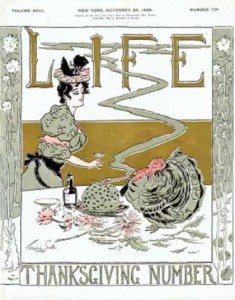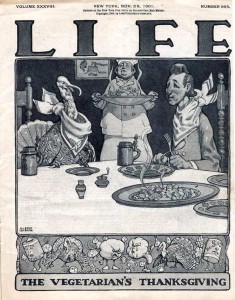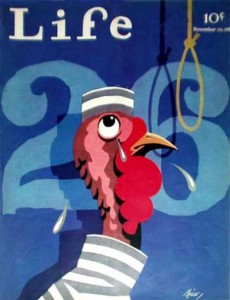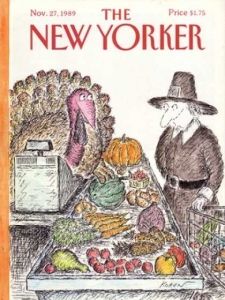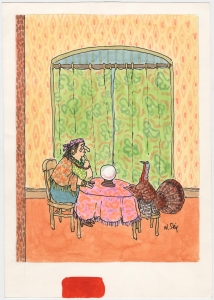
William Steig (1907-2003); Untitled [turkey with fortune teller], 1992; Cover illustration for The New Yorker; Ink and watercolor on paper; Norman Rockwell Museum Collection, gift of Jeanne Steig, NRM.2010.53.1.18
It doesn’t take a genius to figure out what will be happening to many of the farmed and wild turkeys of American by the forth Thursday of November. But what strikes me as an interesting take on the subject is the preponderance of illustrations and cartoons that demonstrate sympathy for the turkey. William Steig’s 1992 Thanksgiving New Yorker cover watercolor illustrates the sadness a gypsy fortune teller feels over the turkey’s fate she ‘sees’ in her crystal ball. This cover is a favorite of mine not only for the empathy between woman and bird, but also for Steig’s typical attention to the details of pattern seen in the table covering, the door curtain, the gypsy’s shawl, and the wall paper.
George Smith; Thanksgiving Number; Cover illustration for Life v. 18 no. 726 (November 26, 1896)
I find it fascinating that sympathy for the turkey has been a rather regular feature of holiday focused illustrations since the late 19th century. In the Life magazine cover by George Smith from 1896, we see a live turkey strutting on the table top who, along with the elegant woman holding a wine glass, are admiring the steaming food at their feast—a Spotted Dick pudding. Spotted Dick is a traditional English holiday pudding.* Notice the chrysanthemums on the table top and in the side borders being used as a season specific decoration.
Albert Levering (1869-1929); The Vegetarian’s Thanksgiving; Cover illustration for Life v. 38 no. 995 (November 28, 1901)
Albert Levering’s Thanksgiving illustration for Life from 1901 shows a man and a turkey seated at their dinner table with napkins tied around their necks. Their dinner, on the table and being served, is exclusively cooked vegetables. Levering has created some wonderful details in this illustration. The lower border decoration is anthropomorphic with weeping vegetables (both canned and fresh) interspersed with happily dancing turkeys and an outer edge to the border of raised forks. In the illustration proper, two of the dinner plates have a border design that appears to be cauliflower florets. In 1896 Massachusetts’ Dedham Pottery opened making white-glazed pottery and plates that initially had a decorative border in cobalt blue of crouching rabbits circling the edge. Eventually the decorations included a variety of other animals such as turtles, elephants, and chicks. Levering’s twist on Dedham Pottery designs is to make the border vegetable instead of animal. The last humorous detail may be seen on hanging on the far wall. In the illustration you can see a picture of a tree stump with a hatchet buried in it, referring to the normally contentious behavior between man and turkey that typifies Thanksgiving Day.
Henry Heíer;
Henry Heíer may have been sympathetic about the Thanksgiving turkey’s impending doom, but on the 1931 Life cover there is no redemption, only a hangman’s noose and the date of the deed in the background.
Edward Koren (1935- ); Untitled [Turkey at cash register checking out vegetarian groceries for Puritan]; Cover illustration for The New Yorker (November 27, 1989)
In 1989 The New Yorker Thanksgiving cover by cartoonist Edward Koren imagines a happy holiday solution. Behind the cash register checking out the myriad of vegetables on the conveyor belt stands the turkey making eye contact with a Puritan standing at the opposite side of the belt smiling as the raw ingredients for his later feast are tallied. Like Levering’s Life cover illustration from 1901, turkey and American man have found common ground where both are happy with the solution.
May our Thanksgiving celebrations bring us together so that we might bury the hatchet (when necessary) and happily share the bounty of our board with each other.
* The spots in Spotted Dick are either currants or raisins.
November 15, 2012
By Joyce K. Schiller, Curator, Rockwell Center for AmericanVisual Studies, Norman Rockwell Museum


